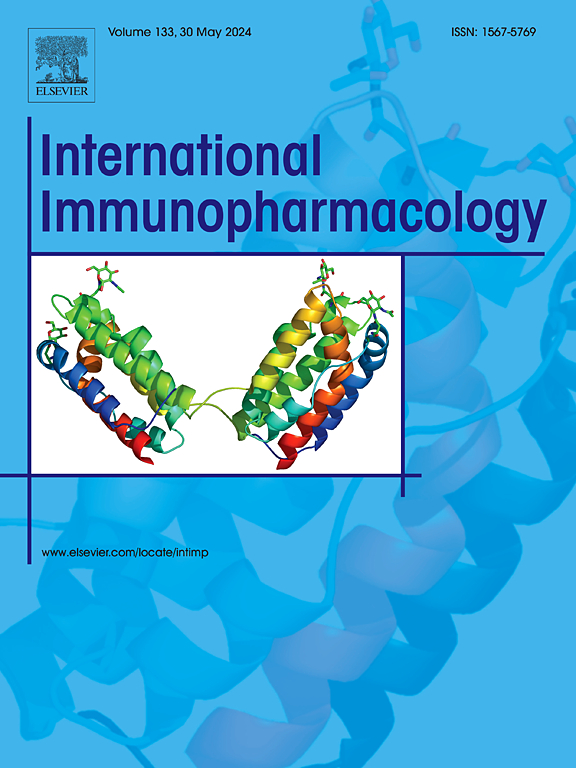PINK1通过调节MFN2影响线粒体氧化磷酸化,缓解糖尿病肾病
IF 4.8
2区 医学
Q2 IMMUNOLOGY
引用次数: 0
摘要
背景:糖尿病肾病(DKD)被广泛认为是糖尿病常见的主要微血管并发症。Mitofusin 2 (MFN2)与糖尿病的发展密切相关,但其在DKD发病机制中的确切作用仍不确定。我们当前研究的目的是探索MFN2在晚期DKD中的作用及其潜在的分子途径。本研究旨在探讨MFN2在DKD进展中的作用及其分子通路。方法在高糖(HG)处理的HK2细胞中处理MFN2,研究其对细胞增殖、凋亡和线粒体氧化磷酸化的影响。在db/db小鼠中建立MFN2过表达或沉默模型作为糖尿病模型。评估肾脏形态学、肾纤维化严重程度、巨噬细胞极化及相关炎症因子(肿瘤坏死因子-α [TNF-α]、白细胞介素-6 [IL-6]、白细胞介素-1β [IL-1β])的改变。进一步,将HK2细胞与m1型巨噬细胞共培养,研究MFN2表达对巨噬细胞极化的影响。随后,我们深入研究了利用STRING数据库的上游机制。结果在hg处理的HK-2细胞中,MFN2表达下调。MFN2过表达导致HK2细胞增殖增加,氧化磷酸化程度提高,细胞凋亡减少。在db/db小鼠中,MFN2过表达对dkd诱导的肾病和纤维化具有保护作用。值得注意的是,MFN2过表达通过促进线粒体氧化磷酸化影响巨噬细胞极化,调节相关炎症因子的表达。此外,STRING数据库预测显示pten诱导的激酶1 (PINK1)调节MFN2的表达,这与DKD中MFN2的变化一致,并且这种调节与DKD的进展有关。结论MFN2在DKD中维持线粒体功能的作用可能受PINK1调控,为DKD提供了新的潜在治疗靶点。本文章由计算机程序翻译,如有差异,请以英文原文为准。
PINK1 affects mitochondrial oxidative phosphorylation by regulating MFN2 to alleviate diabetic kidney disease
Background
Diabetic kidney disease (DKD) is widely recognized as a prevalent and major microvascular complication of diabetes mellitus. Mitofusin 2 (MFN2) has been closely linked to the development of diabetes mellitus, yet its precise role in the pathogenesis of DKD remains uncertain. The objective of our current research was to explore the role of MFN2 in the advanced DKD and its underlying molecular pathway. This research was to examine the involvement and molecular pathways of MFN2 in the advancement of DKD.
Methods
In this study, MFN2 was manipulated in high glucose (HG)-treated HK2 cells to investigate its impact on cell proliferation, apoptosis, and mitochondrial oxidative phosphorylation. Models of MFN2 overexpression or silencing were established in db/db mice as a diabetes model. The alterations in kidney morphology, renal fibrosis severity, macrophage polarization, and related inflammatory factors (tumor necrosis factor-α [TNF-α], interleukin-6 [IL-6], and interleukin-1β [IL-1β]) were evaluated. Furthermore, HK2 cells were co-cultivated with M1-type macrophages to examine the impact of MFN2 expression on macrophage polarization. Subsequently, we delved deeper into the upstream mechanisms utilizing the STRING database.
Results
Our study identified that MFN2 expression was downregulated in HG-treated HK-2 cells. The overexpression of MFN2 resulted in increased HK2 cell proliferation, improved degree of oxidative phosphorylation, and reduced apoptosis. In db/db mice, MFN2 overexpression exerted a protective effect on DKD-induced nephropathy and fibrosis. Notably, MFN2 overexpression influenced macrophage polarization and modulated expression of related inflammatory factors by promoting mitochondrial oxidative phosphorylation. Additionally, STRING database prediction revealed that PTEN-induced kinase 1 (PINK1) regulated MFN2 expression, which was consistent with MFN2 changes in DKD, and this regulation was associated with DKD progression.
Conclusion
The role of MFN2 in maintaining mitochondrial function in DKD may be regulated by PINK1 and provides a new potential therapeutic target for DKD.
求助全文
通过发布文献求助,成功后即可免费获取论文全文。
去求助
来源期刊
CiteScore
8.40
自引率
3.60%
发文量
935
审稿时长
53 days
期刊介绍:
International Immunopharmacology is the primary vehicle for the publication of original research papers pertinent to the overlapping areas of immunology, pharmacology, cytokine biology, immunotherapy, immunopathology and immunotoxicology. Review articles that encompass these subjects are also welcome.
The subject material appropriate for submission includes:
• Clinical studies employing immunotherapy of any type including the use of: bacterial and chemical agents; thymic hormones, interferon, lymphokines, etc., in transplantation and diseases such as cancer, immunodeficiency, chronic infection and allergic, inflammatory or autoimmune disorders.
• Studies on the mechanisms of action of these agents for specific parameters of immune competence as well as the overall clinical state.
• Pre-clinical animal studies and in vitro studies on mechanisms of action with immunopotentiators, immunomodulators, immunoadjuvants and other pharmacological agents active on cells participating in immune or allergic responses.
• Pharmacological compounds, microbial products and toxicological agents that affect the lymphoid system, and their mechanisms of action.
• Agents that activate genes or modify transcription and translation within the immune response.
• Substances activated, generated, or released through immunologic or related pathways that are pharmacologically active.
• Production, function and regulation of cytokines and their receptors.
• Classical pharmacological studies on the effects of chemokines and bioactive factors released during immunological reactions.

 求助内容:
求助内容: 应助结果提醒方式:
应助结果提醒方式:


